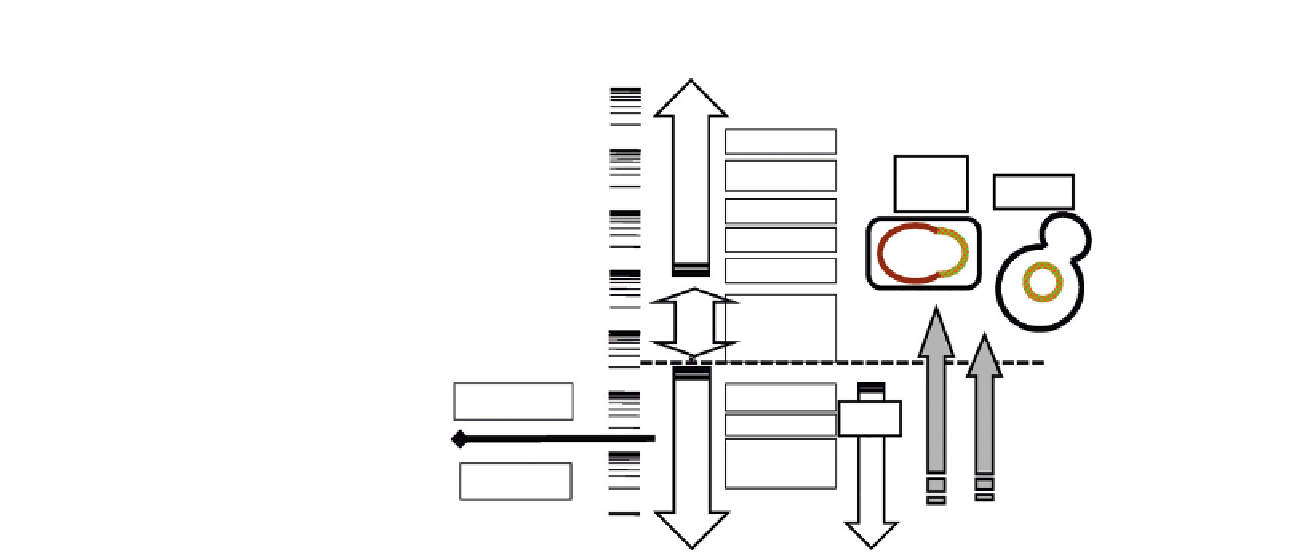Biology Reference
In-Depth Information
Nucleotides (in kbp)
10
7
Mamals
10
6
BGM
vector
Plants
Yeast
10
5
Insects
Nematodes
Yeast,fungi
10
4
~3,500kb
Bacteria
Archeae
10
3
~1,660kb
10
2
Symbionts
Plastids
Big DNA
BAC
10
Mitochond-ria
Small DNA
1
FIGURE 12.1
Variation of cellular genome size. Genome sizes are shown in kbp in log scale with representative species. A horizontal
dotted line indicates a 585 kpb, the smallest natural genome of the free-living organism, M. genitallium. The bold horizontal
line indicates the size to discriminate large and small DNAs used in the text. Two hosts for recombinant genome production,
B. subtilis and yeast are schematically drawn. The structural difference for guest genomes, circular in yeast and chimera
with B. subtilis genome, are illustrated. The largest guest genomes reported to date, 3500 kbp from Synechocystis
PCC6803,
3
and 1660 kbp from Prochlorococcus marinus MED4
4
are indicated by vertical arrows to the right. Stable BAC
clones are available below 400 kbp only.
5,6
226
A technological breakthrough occurred in 2005
3
and 2008,
4
when a large DNA such as a
whole bacterial genome was demonstrated clonable and manipulatable by use of novel
cloning hosts,
Bacillus subtilis
168
3
and Bakers
yeast,
Saccharomyces cerevisiae
.
4
6
The impact
of entire genome synthesis on modern biology is obvious. All genetic information for
cellular life is under our manipulation, and is causing a paradigm shift in all areas of life
science. Any working hypothesis in modern cellular sciences and biotechnology
development should be examined by experiments where truth lies only in observed
reproducibility.
'
To know the genome
should ultimately be verified after
synthesis of
'
'
'
7
This chapter will also cover sketches where abundant synthetic genomes are
available for potential new organisms in coming years.
genomes.
'
DNA SIZE LIMIT BY E. COLI PLASMID
DNA cloning in
E. coli
is performed using plasmid vectors. An
E. coli
plasmid vector cloning
system covers most small DNA fragments in
Figure 12.1
. In addition, a Bacterial Artificial
Chromosome (BAC) vector is frequently used to clone large DNA fragments.
8
Even DNA
fragments stably maintained by a BAC vector of around 100
200 kbp remain far below the
smallest existing genome, i.e. the
Mycoplasma genitalium
, as illustrated in
Figure 12.1
.
Recovery of high-quality BAC DNAs in a large quantity normally requires a mild extraction
protocol to reduce shearing. The protocol includes time-consuming and labor-intensive
cesium chloride gradient ultracentrifugation,
8,9
and therefore quality and quantity are often
trade-offs in terms of time and labor in the preparation of large DNA. To address this issue,
a novel one-step preparation of DNAs as large as BAC clones was developed very
recently,
10,11
as described below.


